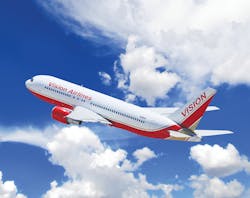Vision Airlines began as a charter company in 1994 and was primarily operating charter service from Las Vegas to the Grand Canyon, a business that grew into a full-time charter gig flying all types of passengers, including politicians, sports teams, and celebrities.
Comments Bill Maloney, Vision director of business development, "We then started expanding our fleet with larger aircraft and flying for the U.S. government, some resorts and casinos … that business has grown, and last fall we began scheduled service."
The Northwest Florida Regional Airport (VPS), which serves the Florida Gulf Coast resort cities of Destin and Fort Walton Beach, has been a key partner in the Vision business strategy. The airline currently provides non-stop service to 18 cities from VPS and is near to surpassing Delta as the lead market-share carrier.
Says airport director Greg Donovan, "Vision is an established charter operator and a Part 121 carrier, but when it was considering going into the scheduled carrier business, we saw something with them pretty early on - that there was an agility that a smaller company has over some of the other mainline or legacy carriers. That agility is to go into not fully-defined markets in terms of origin and destination."
Maloney says the airline is trying to follow a lot of what Allegiant has done, which is provide direct service to leisure destinations from underserved markets. "That’s been our goal on the scheduled side … to really try and replicate what Allegiant has done in other markets. For us, whether it’s Destin or some of these other Southwestern cities.
"Also, I think when we say leisure focus, because we go into most of these cities with less-than-daily service, it really is designed around a vacation experience."
Achieving to sustaining
Vision wasn’t necessarily interested in data that comes from statistical O&D factors of existing routes, says Donovan, "They wanted to find something entirely different," he explains.
"For us, we’ve had over the past four years, a maturity in our relationship with the hotel industry, and understanding what the hotel and resort industry has known for a long time ... where people are coming from.
"The lack of service into our airport, and the region as a whole, kept a lot of the passengers from coming here as frequently as they potentially could.
"We put together data from our industries and shared that with the airline; we showed them markets that were strong from a driving standpoint ... from an air service standpoint, there is a lot of potential for development."
Says Maloney, "We allowed hubbing as far as connecting routes because people were doing it on their own; they were stacking us – allowing people to continue or make the transfer in Destin - this way passengers didn’t have to recheck a bag and come back in.
"So consumers primarily drove the hubbing mentality. One of the reasons we chose Destin is because it is such a great market that was underserved from an air service standpoint.
"I think you find in a lot of places, especially here in the Southeast ... these regional leisure destinations, and Destin has been one of those for many years. For us to help that grow was really important; that is why we chose Destin as our focus."
In May, 111,566 total passengers (enplanements and deplanements) came through VPS. “That’s a 57 percent increase from May of 2010 and breaks a 54-year history here," comments Donovan.
"Sustaining that service long-term is a community effort, not just an airport responsibility. There is a lot of competition on the Gulf Coast between airports, and the key element for us is describing to the community outside of the aviation profession that taking a market share from an adjacent airport really doesn’t grow the economy.
"The key is opening up new markets and bringing people in that wouldn’t normally come. The product that Vision is offering is distinctly different than what the other services offered in the region are."
Donovan relates that one rental car company had $556,849 in gross sales in May alone, and fuel pumped went from some 378,000 gallons to 629,000 gallons in one month. "We had an $84,000 increase in concessions [a 46 percent increase from May 2010]," he adds.
"More than 30,000 passengers in May were Vision passengers; the majority of the recent increase in activity here is either related to its passengers, or the competition that it has inspired."
A partner airport
"We don’t have a mandate or a list of must-haves when we go into a market, but we try to look for a leadership from the airport that understands our goals, understands our model, and will help us be a success in that community," says Maloney. "That can be a variety of different things, whether it’s marketing, local support, or consideration of fees.
"In some of these markets we have had a lot of success, for example if you talk to someone like Greg Donovan, where they just really became our partners locally and really helped open doors … transferred the data into real local knowledge.
"It’s about helping us understand what works and making it a win/win for everybody." Vison has done some co-op marketing with different airports.
When it comes to shared-use functionality, Maloney says it helps but it is not primary. Donovan relates that the old style of having assigned gate and ticket counters is quickly becoming obsolete. "We’re adding a 6,000-sqare foot addition to the terminal, but all of it is shared use," he adds. "It gives us flexibility, especially when having that less-than-daily type of schedule … to use gates the most efficient way possible.
"Although we are adding on to the terminal space, the goal ultimately is to keep from having to make large capital investments in space … if you can utilize what you have more efficiently, the property managers love it, and the airlines love it." The airport partnered with AirIT in providing a shared-use infrastructure platform for Vision.
When it comes to servicing aircraft, Maloney relates that the carrier has seen locations with turn-key packages for a flat fee to do above and below-wing services, such as Chatanooga.
"Those are great solutions, especially for some of these airports that get less traffic," he says. "It’s either us servicing the aircraft, or the Chattanooga-type model, or some third-parties in other locations."
Service details
On customer service, Vison offers the Loyalty Club prgram. "We think it’s kind of a new concept we hope will be well received; so far it has," remarks Maloney.
"Instead of accruing loyalty points, members will now be able to use the membership to get discounts and benefits at whatever destination they are going to. We are really launching it in the Destin area, and it includes attraction discounts.
"It really allows people to pass on savings into their vacation and allows local businesses to get some residual benefit from Vision being in town."
With regard to fleet type, Vision is focused primarily on two types of aircraft, the Boeing 737 and the Dornier 328. "Distance is a factor, size is a factor, size of the market; the shorter routes and smaller cities were some we selected for the 328s, and the longer routes and bigger catchments were the focus of the 737s," says Maloney.
Says Donovan, "Vision announced that it is scaling back some cities, but this is on the heels of starting service to five new cities June 1st. What happens with a company like Vision ... it will dial in what works; it’s not going to stay long in markets that aren’t going to make the bottom line for it as a business."
Business threats include fuel and the economy, says Moloney. "The nature of our business being aviation ... there is always some curve ball out there that you can’t plan for but just have to adjust.
"It is certainly an evolving and dynamic industry; we think the competition and consolidation will create new opportunities for us whether that be through partnerships with some of the other carriers, or it be in routes that were previously served, or in creating new routes."
Serving the Emerald Coast
The Northwest Florida Regional Airport (VPS) set a record in May accommodating 111,566 passengers, far exceeding any previous monthly traffic level. The increase was largely the result of new, non-stop air service to some twenty destinations served by Vision Airlines.
The number of passengers utilizing the airport in May represented a 57.2 percent increase from May of last year and exceeds the highest historical monthly tally set the previous month in April of 96,788 passengers; the passenger figure tops the busiest month in the airport's 54-year history.
Vision Adds Grand Bahama Island
Vision Airlines has signed an agreement with the Grand Bahama Island Tourism Board to begin service in November. The airline’s flights will originate from Fort Lauderdale, Louisville, Kentucky; Richmond, Virginia; Raleigh/Durham, North Carolina; and Baltimore/Washington International Airport. Additionally, direct flights (one-stop, no change of plane) will be available from Northwest Florida Regional Airport.
Richmond, Raleigh/Durham, and Baltimore/Washington will also be new network destinations for Vision when it launches service from these U.S. cities to Grand Bahama Island International Airport (FPO).
Freeport is the main city on Grand Bahama Island and is the second-largest city in The Bahamas. Grand Bahama International Airport is one of two Bahamian airports that have U.S. Customs and Immigration pre-clearance facilities.
Says Maloney, Vision director of business development, "Louisville and Ft. Lauderdale are Vision markets already, and BWI, Raleigh-Durham, and Richmond will be new to us; we are excited to go into those markets."
About the Author

